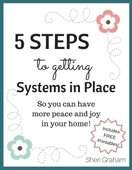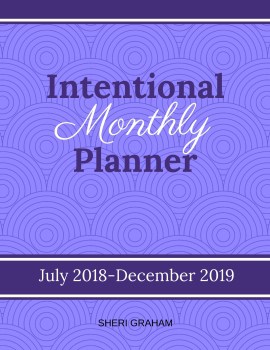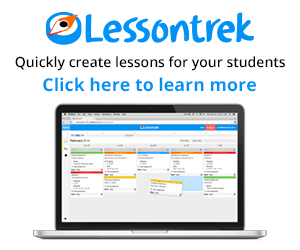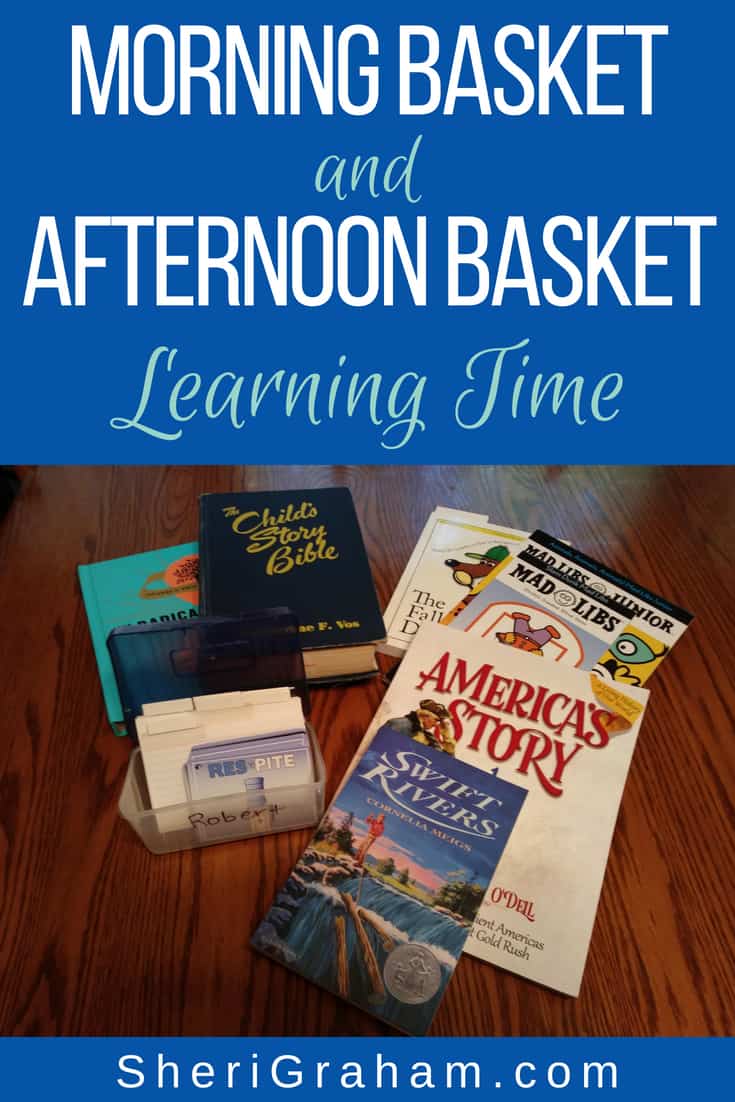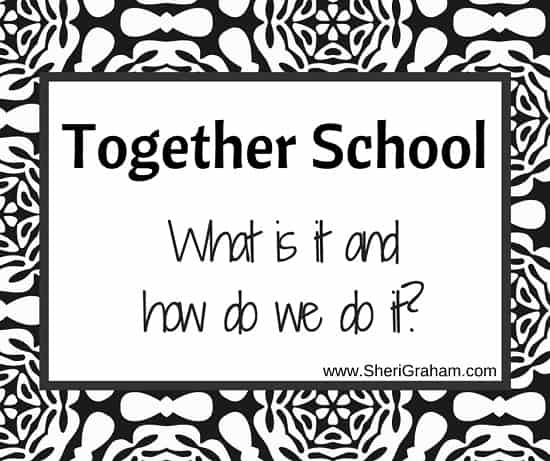Dealing with Pressure? The Benefits of Slowing Down (in your homeschool)
Post may contain affiliate links. As an Amazon Associate I earn from qualifying purchases.
Today I am featuring an article by a wonderful homeschool mom and curriculum provider, Diana Waring. She has some great thoughts to share and I thought with the new homeschool year starting for many of us, it was very timely as well! Enjoy!
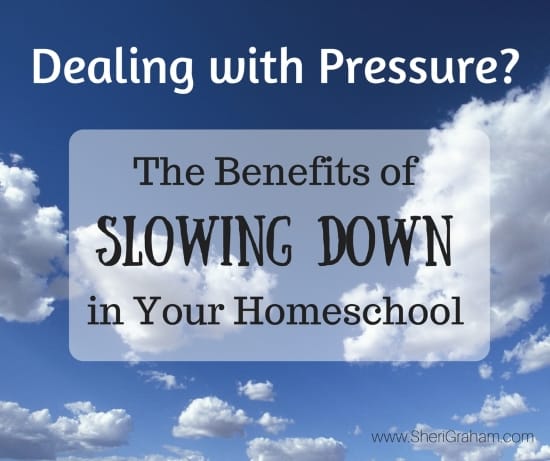
By Diana Waring
You know the story of the frog in the kettle, right? The one where the frog remains in water that used to be a healthy temperature? As you remember from that story, not being aware of the rising heat in your circumstances has a very bad outcome!
Across our modern culture, there is a similar increase in the “temperature” of our daily tempo. We scurry here; we run there; we have impossible to-do lists that never get done. Fast food, fast travel, movies on demand, and instant books on e-readers allow us to go through life at a dead run. The pressures of daily living have risen to red-hot, but—like the frog—we remain in this environment.
To this “normal” pressure-driven life, hundreds of thousands of us have added homeschooling our children. And, because of the massive expectations placed upon homeschoolers to have perfect children with phenomenal academic success, we feel an incredible weight added onto our shoulders to do all of this and more. The highly pressured, 21st century pace of life applied to school becomes fast education.
My definition of fast education: Know it all; do it all; finish it all—better and more quickly than ever before.
The problem with fast education is not only that it does not work, but that it can actually harm the development of our children.1 As much as fast food negatively affects our physical health, so fast education negatively affects a child’s curiosity, creativity, and problem-solving ability.
How, then, do we combat this educational pressure in our homeschooling? Begin by rethinking the learning goals for your children. Choose which of these is more important:
Finish the textbook by the end of the year.
OR
Have an engaged discussion with your students about something they learned in the textbook—one which demonstrates not only memory but mastery of the material.
Get 100% on a standardized test.
OR
Demonstrate an ability to take what is presented in a textbook to a deeper level, asking questions and pursuing answers beyond the book.
Begin college at an unusually early age.
OR
Show a vibrant approach to life; be interested in many topics; be able to learn independently, and be confident and mature.
The purpose of these choices is to highlight the fact that, when it comes to education and child development, the path is more important than the destination. Taking the time to follow a passion (like art or science experiments or writing or sports) often provides a richer, more balanced, and stronger foundation for adulthood than rushing through academics at the speed of light. These pursuits develop endurance, patience, self-motivation, and a delight in learning—all of which are extraordinarily helpful in any endeavor. So, rather than the destination of graduation (with university or career afterwards,) we focus first on the path of learning—loving to learn and knowing how to learn independently.
With that path in mind, here are two practical suggestions (though you will discover many more) as you start down the path of s-l-o-w-i-n-g down.
First Suggestion
Make room in your daily or weekly schedule for letting your kids brainstorm something interesting to do or some creative project they would like to make. Sometimes this would connect to something they are studying, but sometimes it can be self-directed.
When my high-school age daughter was studying the Roman Empire and the early Church, she decided to capture what she had learned by shooting a video of a television news broadcast from 155 A.D.! The breaking news of that show was the recent martyrdom of the 2nd century Church bishop, Polycarp. As she and her brothers brainstormed how to pull this off, they decided to rearrange furniture to create a desk for the “news anchor,” and they created theme music for the show and even two hilarious TV commercials. My daughter played the part of the on-the-spot-reporter who had witnessed the last words of Polycarp and had observed the effect they had on the huge crowd who had come to see him killed. I can still remember the awe I felt as she presented the scene with a fresh, creative perspective.
The Benefits
Allowing your kids to have this kind of creative time can lead them to their passion. It can also help them become a problem solver, as they find their way through issues arising in the creative process.
Second Suggestion
Encourage your children’s curiosity. When they ask, “Why do leaves turn colors?” consider shutting the books and going outside. Of course, you can simply do an internet search on “why leaves change color,” but that pales in comparison to the experience of sliding your feet through piles of fallen leaves, looking for the most interesting leaves, pressing those leaves between paper for preservation, drawing a picture and writing a description of your favorite leaf, looking in a field guide to discover what kind of trees dropped these leaves, and looking in an encyclopedia or on the internet for the explanation of why leaves change color. Which would your children prefer—a 30-second internet search or a 45-minute exploration of your yard? It takes 44.5 minutes longer, but having the time to investigate, ponder, draw pictures, ask questions, and discover answers will fuel their wonder and their hunger to learn.
(Not every question takes this sort of shut-the-book, go-outside response. Some are just for a forgotten fact. But when they turn to you with that look on their faces because they are pondering life’s inexplicable questions, then you can engage with all of the hands-on, interest-driven exploration.)
The Benefits
Encouraging your children’s curiosity will develop self-motivation, as they are allowed to find answers to what interests them, to learn about things beyond the curriculum, and to “think outside the box.” They will also remember more deeply what they have learned through their own exploration and discovery.
The effects of slowing down educationally are the opposite of what you might expect. Rather than learning less, surprisingly, children will actually learn more, at a deeper and more interconnected level. Their self-motivation, their ability to learn independently, their skill at problem-solving, and their joy in learning will develop over time and through many experiences. As a matter of fact, “over time and through many experiences” is the curriculum for these highly desired qualities.
The take away? When it comes to your children’s education, turn down the heat. In other words, s-l-o-w down!
A pioneer in homeschooling, author of the Experience History Through Music series and History Revealed curriculum, and international speaker—four continents and counting!—Diana Waring cares about how people learn as well as what they learn. Follow her witty and practical blog at dianawaring.com/blog; check out her fast-paced, God-honoring, sit-on-the-edge-of-your-seat-in-suspense world history products, and discover America’s history through folk music in the new Experience History Through Music series. Learning has never been this fun!
Endnote:
1 https://www.early-childhood-education-degrees.com/the-pre-planned-childhood/
Copyright, 2015. Used with permission. All rights reserved by author. Originally appeared in The Old Schoolhouse® Magazine, the family education magazine, Fall 2015. Read the magazine free at www.TOSMagazine.com or read it on the go and download the free apps at www.TOSApps.com to read the magazine on your mobile devices.

